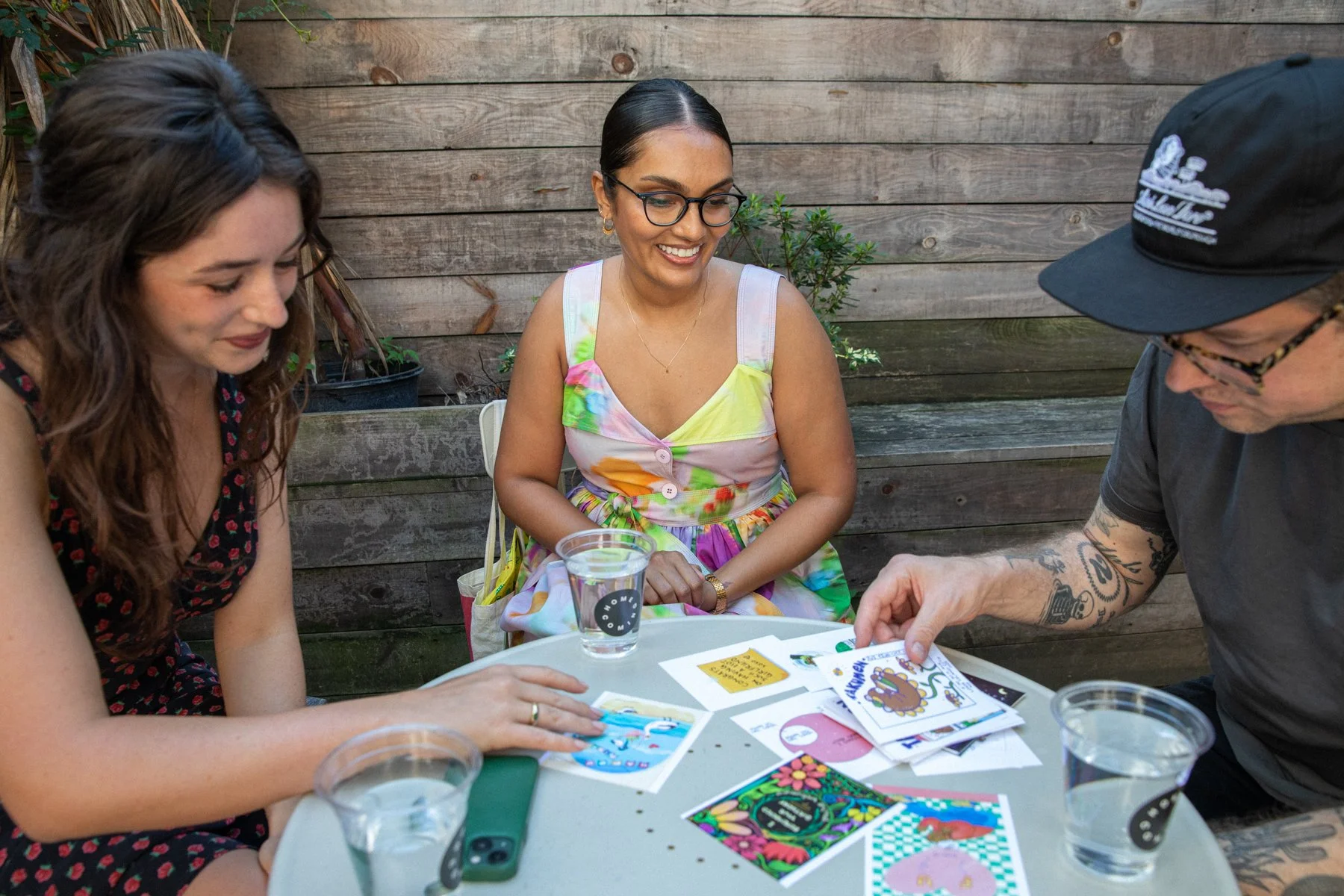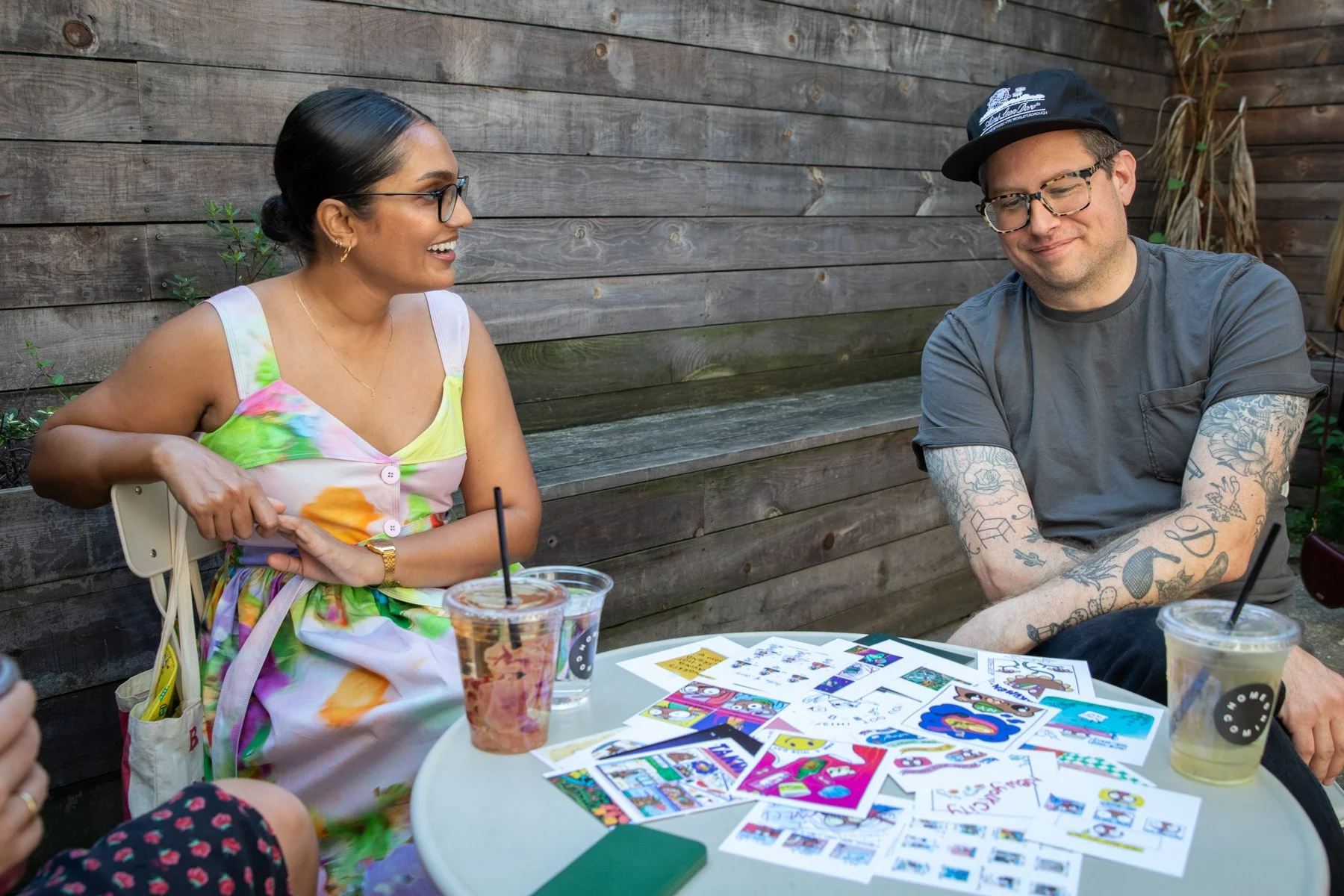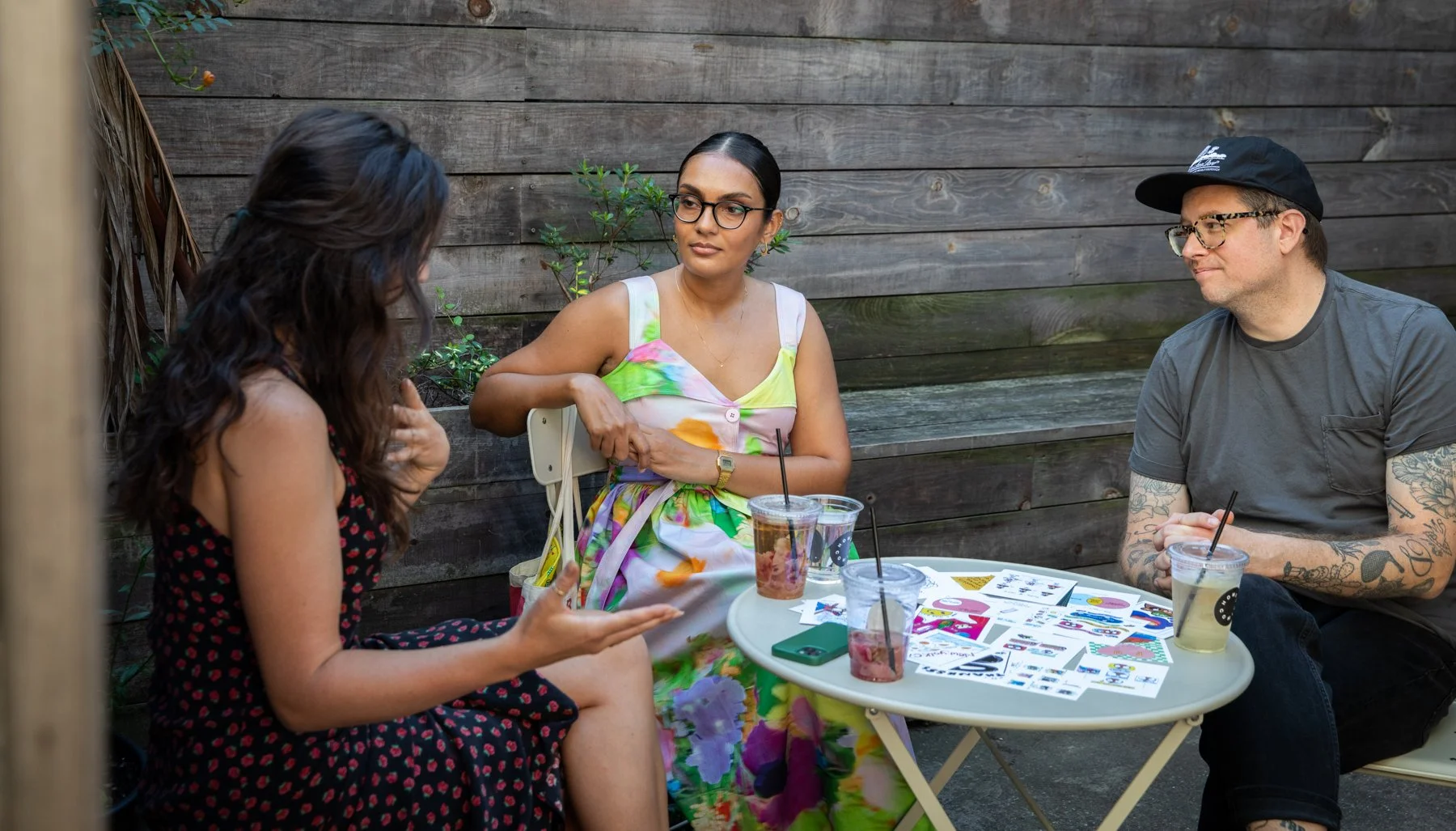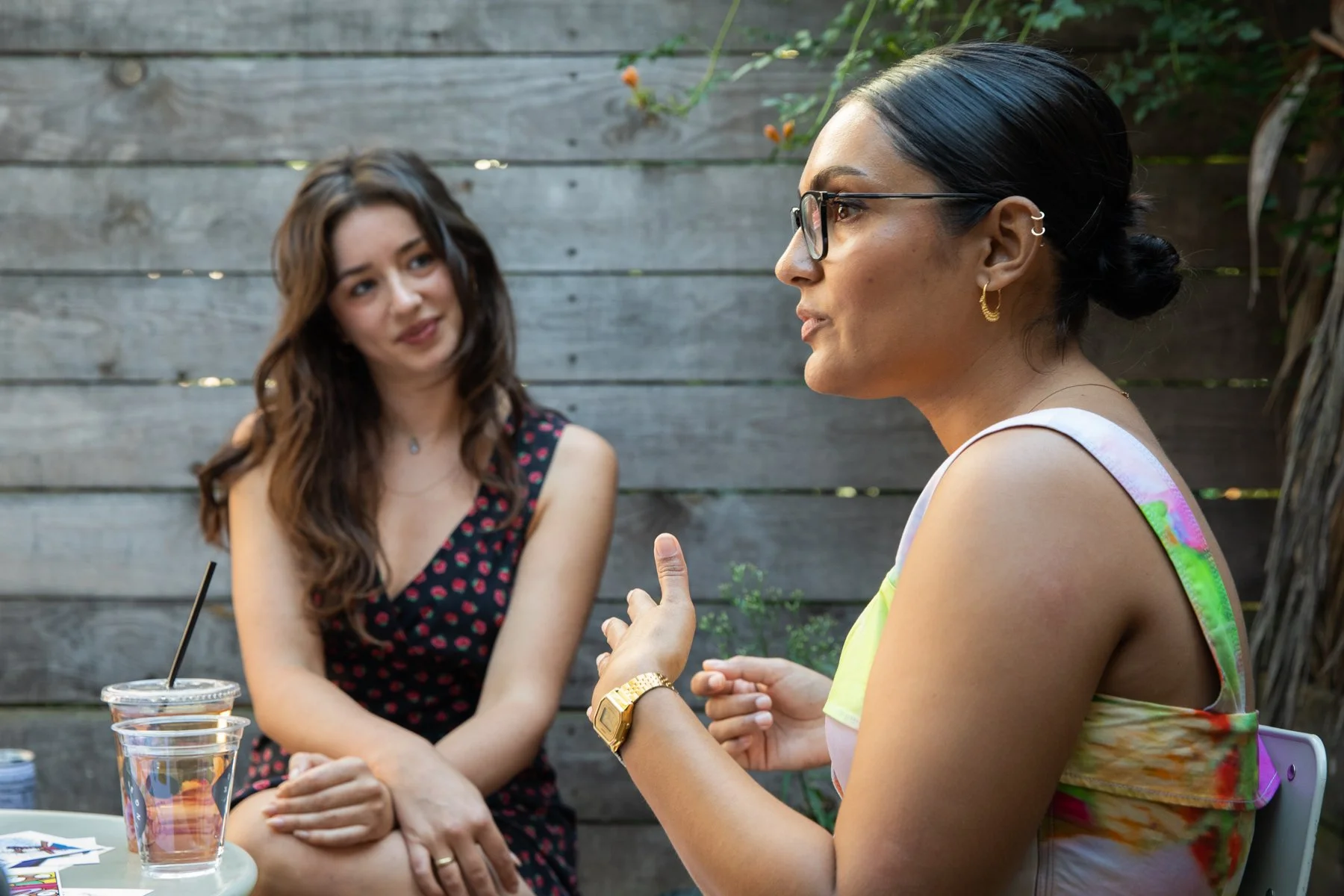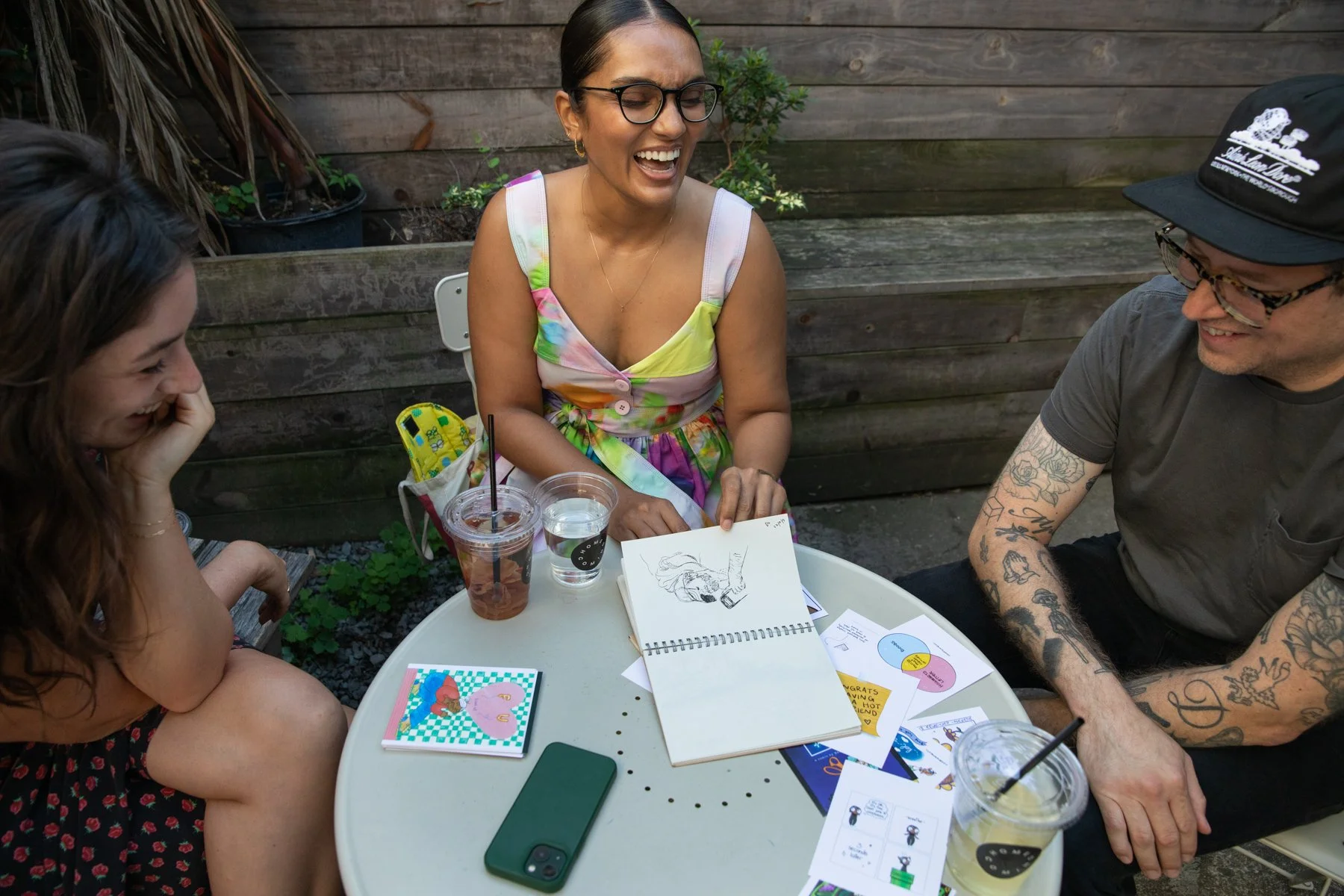Raising Your Voice with Christine Rai
As long-time admirers of Christine Rai’s work, it’s hard to keep a cool composure when she arrives at the coffee shop. Her skillful command of multiple mediums and quick wit combine in a compelling oeuvre of work. You probably recognize her comic series, Yeah It’s Chill, which earned a vast online audience in recent years. It’s an exercise in creative expression as an exploration of truth, communicating honest experience with a self-aware humor and light touch.
The same familiarity and specificity behind her comics is echoed throughout an energetic, laughter-filled conversation. We met Christine as fans; we left as friends. Everything that happened in-between is for you to enjoy.
Pictured (left to right): Katie Danforth, Christine Rai, and John Samels.
Katie Danforth: I’d love to start with an overview of your creative journey. From childhood hobbies, or school, how did you arrive at a full-time, thriving artistic career?
Christine Rai: Like a lot of people, I’ve always loved art. I was always academically motivated; for a long time, I was really focused on going to med school. So I pushed my love of art aside to pursue that. In college I majored in biology and I minored in fine art.
John Samels: What a combo!
CR: It was really fun, and they kind of go hand-in-hand. All of nature is creative. But, when I was studying for the MCAT, I realized that I was not doing what I was supposed to be doing. Still, I was like, I have to use my degree to some extent. I was a pharmacy technician, I worked at startups, and then I settled on being a project manager. While I was a project manager, I really missed being creative. So as a side project I started a self-published coloring book. This was in 2016, when coloring books for adults were taking off. It was also at the time of the 2016 election and my coloring book was of curse words in different languages. It kind of hit this sweet spot of what people were looking for.
KD: Self-care, mental health awareness, outlet for rage and frustration…
CR: All of that. Buzzfeed picked it up and it went semi-viral and I got a lot of sales from that. So then I was like, I can pursue this career path. So while I was figuring out a publishing company, and working on other self-published stuff, I started my comic series, Yeah It's Chill, based on my experience and anxieties around starting my own business. And then that comic ended up getting picked up by a bunch of places. I started getting clients from the Instagram account, and now here we are a few years later. I started that in 2017, and I've been a full-time artist since 2019.
Artwork by Christine Rai. Images courtesy of the artist.
KD: I'm sure you've been asked this before, but did you watch Lizzie McGuire as a kid? When I first saw your work, Yeah It’s Chill immediately reminded me of that.
CR: Yeah! The character was kind of based on that: a little cartoon version of me, but very amplified and honest. Definitely loved Lizzie.
KD: I remember as a kid before I even knew what anxiety was, I was obsessed with the way that show gave an external voice to internal thoughts. I was so taken by that concept and visual then, and it's so great to see it now in your work.
CR: [Laughs] I mean, here I am thanks to Hillary Duff.
KD: But back to becoming a full-time artist — I love hearing stories like that. Following instincts and interests until you arrive at the place you were always meant to be, it takes courage.
CR: Thankfully, because I'm from New York, I was able to live with my family until things started taking off. I come from a family of business owners — my family were immigrants and when they moved to the country, everyone kind of started a business where they could. My aunts had restaurants, my dad has a renewable energy company. Seeing them come from not privileged circumstances to get to where they are today, and having their support, definitely helped me to feel like this path is possible.
JS: What do you love most about your art?
CR: I've always been an artist. I've always been someone who doodled in the margins. My dad was a painter, that was one of his hobbies, so I grew up with that. Now as an adult to be able to do something that I love and get paid for it… it just feels like a miracle so many times. Expressing things that are important to me feels so good to be able to do. I make comics about mental health, about puberty, about race — a lot of topics that I would like to see more out there. I’m definitely not overstating anything that I've done, but I like that I'm adding to this narrative.
KD: I'm so curious about the vulnerability behind the comics — it’s so essential and I would imagine it’s part of why the series is so popular. Have you always felt comfortable with vulnerability or has it been an exercise to bring that into your work?
CR: It's definitely been an exercise and something that I've had to cultivate. When I was first starting out, I contacted a few artists I like who are also doing comics, just for advice. The best advice that I got was from my friend Hailey Weaver; she said to be as honest and specific to yourself as you can. And that's how you create work that will connect to people.
That's what I started doing. Comics historically have been a really white male populated area. It's changing, but there aren't too many main characters of color living their lives joyfully. I thought that was important to explore. The character is kind of a different layer of myself so one way that I can kind of be more vulnerable is to think I'm lending my experience to her.
KD: Do fans often reach out with shared experiences or emotions they’ve found in your artwork?
CR: Yeah, that's the nature of social media. My work tends to be relatable, so I do get feedback from people. There's one comic that I did about not being able to sleep because of anxiety, and all the things that I do in the middle of the night instead of sleeping: eating weird food combinations, the ghosts coming out. Everyone was like, Yes! The ghosts are out! It's been great to connect with people that way. Having people who love what I do and support what I do has been incredible. But also I think that being on social media too often can be really detrimental.
KD: Right. There's a lot of good that comes out of sharing things on Instagram, but also a lot of harshness and horrible, unsolicited feedback. And opinions that you didn't ask for.
CR: Yeah. Being a woman on the internet is a whole thing — I’ve gotten unsolicited, negative feedback from work that in my mind is so innocuous. There's one comic that I made about having body hair. That's it! I am a mammal and I have body hair.
KD: Not breaking news, there.
CR: It ended up getting posted on a right-wing message board, where it was berated. That was a new experience, and it happened pretty early on. I think that kind of colored how I interact online. People who are going to react that way are not my people.
KD: In light of the nature of running a business online, how do you maintain positivity when shit like that also happens? Or maintain sensitivity with your character?
CR: I take breaks. When I first started making comics I was posting constantly. I don't do that as much anymore, but that's also because I'm getting more client work, so I don't have as much time to dedicate to it. But when I am creating, I try to maintain that idea that the work is for me first — whoever wants to enjoy it after that is secondary. That perspective also helps.
JS: Has your art led you down any unexpected roads in terms of projects or opportunities?
CR: I recently did an artist residency in Bermuda, that was incredible. It was two weeks at this beautiful hotel with amazing people. I wouldn't have gotten that experience if I wasn't doing this. I was able to bring a guest, so I brought my mom with me. I think at that point she was like, Alright, Christine's got a real job. I’ve gotten to work with really cool people at organizations that I love that just seemed so unattainable. Doing props for Netflix was a dream project. Creating artwork for the Guggenheim was amazing. I've also met so many incredible, inspiring, supportive, cool artists around New York City. I wouldn't have this incredible network of amazing, creative people if I wasn't doing this.
KD: [Laughs] Same!
JS: A network like that is such a great source of inspiration, too. Do you find yourself exploring different modes of expression often?
CR: Definitely! For the Bermuda Artist Residency, I'm woodworking. My dad was a contractor when he first moved to the country. He, along with my mom and then whatever I could do as a child, built the house that we have on Long Island. During the pandemic, my dad was fixing some stuff up around the house and I learned woodworking by helping him with these projects. And then I built a bunch of the furniture in our apartment. Built the headboard, shelves like everywhere…. Our apartment is a railroad, so everything is in an unconventional size. I love tactile work, but I work mainly digitally. This is a way to kind of break out from that. So for the Bermuda project, I'm making wooden sculptures, and then I'm going to paint my comic character onto the sculptures. Beyond that, I love plein air sketching; I always have my sketchbook with me. I love sewing…pretty much any hobby where you make stuff, I've tried it.
KD: You dabble! What's your routine experimentation and rotation of mediums? How do you keep it fresh and exciting for you?
CR: Drawing digitally is something that is always there because it's also so easy — I have my iPad and I can bring it anywhere. Beyond that, it ebbs and flows based on what I feel like doing. Doing things I’ve never done before has really helped my creative brain. I've always been a perfectionist, and I don't want to be — then you're just noodling with a piece of artwork forever and it's never done. So I do like trying new artistic pursuits to be a beginner again and flex that muscle.
JS: How do you usually start a project?
CR: Starting is always like the hardest step, I think. Sometimes I get an idea and I see exactly how this is gonna be, so I’ll go straight to my iPad. Otherwise, I start with sketchbooks.
KD: Starting is the absolutely hardest step! I think when you're young, you assume the trick to creativity is starting with a great idea. But you get older and learn that the real trick, for any medium, is the execution. Most people have ideas, but most people don't know how to make that into action.
CR: Yeah and it'll be horrible the first like a hundred times that you do it, you know? Your taste won't align with this vision in your brain, but eventually it'll catch up. My advice to anyone new to a creative career would be to start doing it without too many expectations, but try to cultivate this belief in yourself, your worth, your value, and the importance of your voice.
This interview has been edited for brevity and clarity.We’d like to thank our friend Christine Rai (@yeahitschill) for joining us. Thank you to Homecoming for hosting this interview. To learn more about artist sourcing opportunities, email us at info@colossalmediagroup.com.

